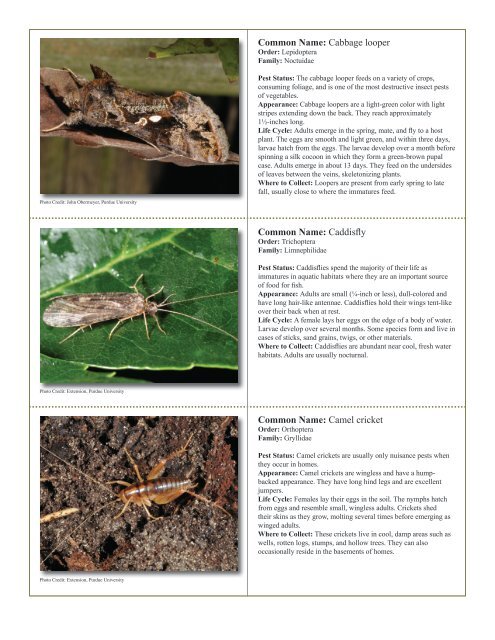to download pdf - Purdue Extension Entomology - Purdue University
to download pdf - Purdue Extension Entomology - Purdue University
to download pdf - Purdue Extension Entomology - Purdue University
Create successful ePaper yourself
Turn your PDF publications into a flip-book with our unique Google optimized e-Paper software.
Common Name: Cabbage looper<br />
Order: Lepidoptera<br />
Family: Noctuidae<br />
Pho<strong>to</strong> Credit: John Obermeyer, <strong>Purdue</strong> <strong>University</strong><br />
Pest Status: The cabbage looper feeds on a variety of crops,<br />
consuming foliage, and is one of the most destructive insect pests<br />
of vegetables.<br />
Appearance: Cabbage loopers are a light-green color with light<br />
stripes extending down the back. They reach approximately<br />
1½-inches long.<br />
Life Cycle: Adults emerge in the spring, mate, and fly <strong>to</strong> a host<br />
plant. The eggs are smooth and light green, and within three days,<br />
larvae hatch from the eggs. The larvae develop over a month before<br />
spinning a silk cocoon in which they form a green-brown pupal<br />
case. Adults emerge in about 13 days. They feed on the undersides<br />
of leaves between the veins, skele<strong>to</strong>nizing plants.<br />
Where <strong>to</strong> Collect: Loopers are present from early spring <strong>to</strong> late<br />
fall, usually close <strong>to</strong> where the immatures feed.<br />
Common Name: Caddisfly<br />
Order: Trichoptera<br />
Family: Limnephilidae<br />
Pest Status: Caddisflies spend the majority of their life as<br />
immatures in aquatic habitats where they are an important source<br />
of food for fish.<br />
Appearance: Adults are small (¼-inch or less), dull-colored and<br />
have long hair-like antennae. Caddisflies hold their wings tent-like<br />
over their back when at rest.<br />
Life Cycle: A female lays her eggs on the edge of a body of water.<br />
Larvae develop over several months. Some species form and live in<br />
cases of sticks, sand grains, twigs, or other materials.<br />
Where <strong>to</strong> Collect: Caddisflies are abundant near cool, fresh water<br />
habitats. Adults are usually nocturnal.<br />
Pho<strong>to</strong> Credit: <strong>Extension</strong>, <strong>Purdue</strong> <strong>University</strong><br />
Common Name: Camel cricket<br />
Order: Orthoptera<br />
Family: Gryllidae<br />
Pest Status: Camel crickets are usually only nuisance pests when<br />
they occur in homes.<br />
Appearance: Camel crickets are wingless and have a humpbacked<br />
appearance. They have long hind legs and are excellent<br />
jumpers.<br />
Life Cycle: Females lay their eggs in the soil. The nymphs hatch<br />
from eggs and resemble small, wingless adults. Crickets shed<br />
their skins as they grow, molting several times before emerging as<br />
winged adults.<br />
Where <strong>to</strong> Collect: These crickets live in cool, damp areas such as<br />
wells, rotten logs, stumps, and hollow trees. They can also<br />
occasionally reside in the basements of homes.<br />
Pho<strong>to</strong> Credit: <strong>Extension</strong>, <strong>Purdue</strong> <strong>University</strong>
















